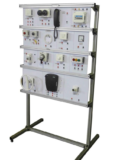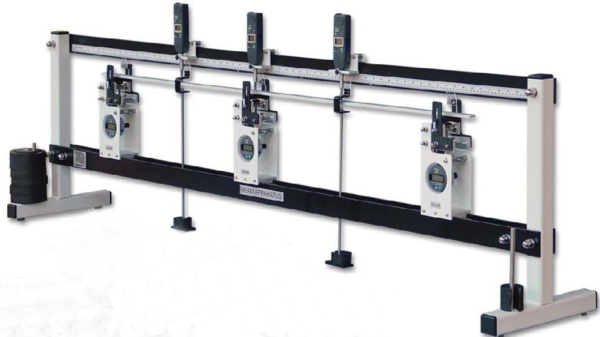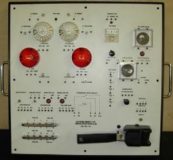Forces on A Beam Apparatus Model MT 133
Home » Products » Forces on A Beam Apparatus Model MT 133
Forces on A Beam Apparatus Model MT 133
Sci-tech Forces on A Beam Apparatus Model MT 133 allows an extensive range of experiments to cover virtually all course requirements relating to bending of beams. The basic unit provides facilities for supporting beams on simple, built-in and sinking supports, applying point loads, and measuring support reactions and beam deflections. It includes five different test beams.
Sci-tech Forces on A Beam Apparatus Model MT 133 can be used for an almost limitless
number of experiments ranging from determination of the elastic modulus for beams of different materials, through to studies of continuous beams with any loading. Great care has been taken at the design stage to ensure maximum flexibility and ease of use.
The main frame of the apparatus consists of an upper cross-member carrying graduated scales and two lower members bolted to T-legs to form a rigid assembly. The three load cells and cantilever-support pillar slide along the lower members and can be clamped firmly in any position. The load cells have direct digital readout and each is fitted with a hardened steel knife edge which can be adjusted to set the initial level or to simulate a sinking support. Locking pins can convert each load cell to a rigid support when required.
The cantilever support is a rigid pillar with a sturdy clamping arrangement to hold the beams when built-in end conditions are required. Four weight hangers and a set of weights are supplied to apply static loads. Three digital indicators measure all beam deflections. The indicators mount on magnetic carriers that slide along the upper cross-member. The indicators, carriers, load cells and weight hangers all have cursors that register on the scale (located on the upper cross-member) to ensure easy, accurate positioning. All digital indicators and load cells have sockets and cables for connection to ‘Sci-Cal’ optional Data Acquisition System.
| Size: | 120cm x 50cm x 90cm (LxWxH) |
| Weight: | 25 kg |
Item Description
Features
• Ideal for student use and classroom demonstrations
• Made for maximum flexibility and ease of use for extensive range of experiments
• Simply supported and cantilever beam tests with up to four supports with any loading
• Three load cells with digital indicators measure reaction forces or act as rigid sinking supports
• Precision digital indicators for accurate deflection measurements
• Weights and hangers supplied to apply point loads
• Supplied with five different test beams
Sci-tech Forces on A Beam Apparatus Model MT 133 allows an extensive range of experiments to cover virtually all course requirements relating to bending of beams. The basic unit provides facilities for supporting beams on simple, built-in and sinking supports, applying point loads, and measuring support reactions and beam deflections. It includes five different test beams.
Sci-tech Forces on A Beam Apparatus Model MT 133 can be used for an almost limitless
number of experiments ranging from determination of the elastic modulus for beams of different materials, through to studies of continuous beams with any loading. Great care has been taken at the design stage to ensure maximum flexibility and ease of use.
The main frame of the apparatus consists of an upper cross-member carrying graduated scales and two lower members bolted to T-legs to form a rigid assembly. The three load cells and cantilever-support pillar slide along the lower members and can be clamped firmly in any position. The load cells have direct digital readout and each is fitted with a hardened steel knife edge which can be adjusted to set the initial level or to simulate a sinking support. Locking pins can convert each load cell to a rigid support when required.
The cantilever support is a rigid pillar with a sturdy clamping arrangement to hold the beams when built-in end conditions are required. Four weight hangers and a set of weights are supplied to apply static loads. Three digital indicators measure all beam deflections. The indicators mount on magnetic carriers that slide along the upper cross-member. The indicators, carriers, load cells and weight hangers all have cursors that register on the scale (located on the upper cross-member) to ensure easy, accurate positioning. All digital indicators and load cells have sockets and cables for connection to ‘Sci-Cal’ optional Data Acquisition System.
The standard test beams are in three thicknesses and include three different materials. They are suitable for the complete range of experiments covering different loading and support configurations. The optional set of beams provide for experiments on different types of beam including compound,
Sci-tech can supply the optional Sci-Cal software & hardware interface which gives accurate real-time data capture, monitoring and display, calculation and charting of all important readings on a computer.
See also different:

Sci-tech Telephone/Video Interphone System Trainer Model ETR 042 has been designed so that students can assemble, analyze and test a wide range of more and more complex electric circuits; it consists of interchangeable modules; thus merely con [...]



